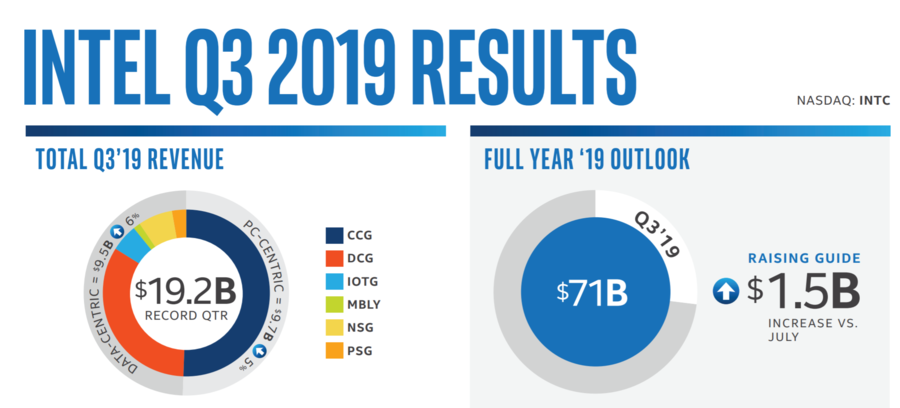AMD and Intel Posted Record Profits Q3 2019
CPU "shortages" on the Intel side of the duopoly helped AMD post the best quarterly results since 2005 while Intel posted a record quarterly result of $19.2 billion. That brings Intel's yearly forecast for the year up $1.5B to $71 billion. AMD posted a Q3 result of $1.8 billion that is ~ 10% of Intel's results, thanks to Zen2 based Ryzen desktop parts and EPYC server chips.
ChipZilla Made Record Profits

Intel's quarterly results. Graphics from Intel's Newsroom
Intel's Robert H. Swan had this to say about Intel's Q3 2019 result in Intel's earnings call Oct 24th, 2019:
"Q3 2019 was the best quarter in our Company's history. We generated $19.2 billion in revenue and a $1.42 in non-GAAP EPS, exceeding our guidance by $1.2 billion and $0.18, respectively. We've achieved record revenue both overall and in our data-centric businesses while making continued progress on our strategic priorities.
(...)
In the third quarter, leading cloud customers ramped our second-generation Xeon Scalable processors with AWS, Google and Alibaba, deploying instances based on Cascade Lake. Customers including BP and TU Darmstadt, selected our highest performance Xeon Scalable platform, the 9200 series for their most demanding workloads. One key reason customers are choosing Xeon Scalable is the platform's built-in workload acceleration for AI."
Intel's record high $19.2 billion Q3 result comes after a quarter with CPU "shortages" and higher prices in the very lucrative "cloud" (someone else's computer in a datacenter somewhere) market. This helped Intel's competitor Advanced Micro Devices (AMD) as well.
AMD's Best Quarterly Result Since 2005
AMD's Q3 2019 result of $1.8 billion was their best result since 2005. It may appear low at less than one tenth of Intel's record result - but Advanced Micro Devices is a much smaller company which was practically bankrupt just a few years ago.
AMDs profits was mostly a result of Zen 2 based 7nm Ryzen desktop CPUs. The "Computing and Graphics" alone made $1.28 billion, up 36% year-over-year. The "Enterprise, Embedded and Semi-Custom segment", on the other hand, was down 27% year-over-year with a result of $525 million. This is primarily due to lower console (XBox/Playstation) sales in the "Semi-Custom" share of that segment; EPYC server CPUs sold very well.
GNU/Linux users who enjoy free games like SuperTuxKart or commercial games from Steam and stores like that tend to prefer AMD graphics cards since Advanced Micro Devices's is alone in offering powerful GPUs with free open source drivers. This segment did do very well in Q3 2019. AMD's "Radeon Technologies Group"'s profits are folded in under "The Computing and Graphics". That segment had an operating income of $179 million - up a whole 79% since a year ago. That figure pales compared to Nvidia's GPU profits - but it is growth nevertheless.
More Bang For The Buck
Competition works and even though there is very little of it in the technology industry - it is, after all, a duopoly on both the CPU and GPU sides of things - it's great that the weaker competitor manages to make a profit when the almost-monopoly raises prices due to "shortages" in order to make record high profits. AMD is now in a much stronger position than they were just a year ago. We fully expect next year to bring even better price/performance than we had this year. There is already one clear indications that Intel is unhappy with Ryzen chips eating some of their desktop revenue: Intels upcoming i3 CPUs raise the bar for entry-level CPUs to four cores and four threads. That core/thread count was reserved for top-of-the-line i7 CPUs just a few years ago. AMD will surely respond and 2020 will likely be a good year to buy or upgrade computers - specially now that RAM prices have normalized and 32 GB DDR4 can be had for what 16 GB DDR4 cost before the RAM-cartel got investigated for creating artificial "shortages". GPUs are the only overly expensive computer component left; prices in that area are still a lot higher than they should be. Consider getting buy with a cheaper used one if you are building a new computer any time soon. The rest of the components are all worth buying at current and expected future prices.

Enable comment auto-refresher